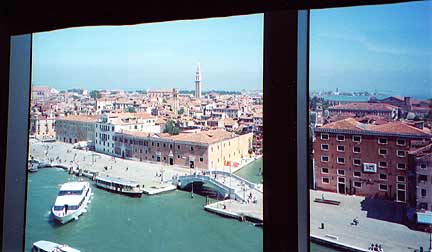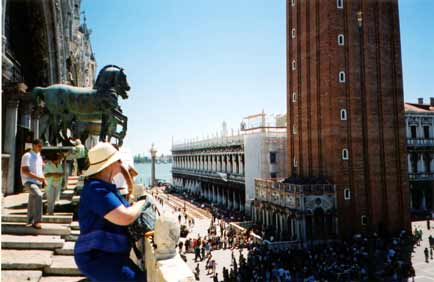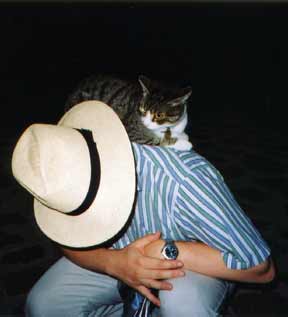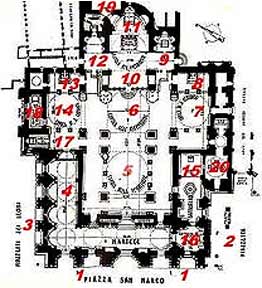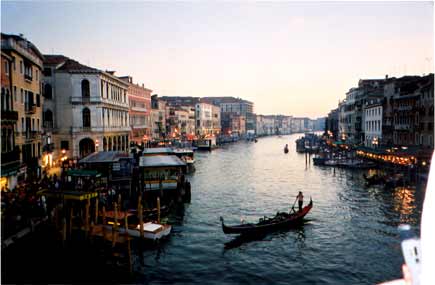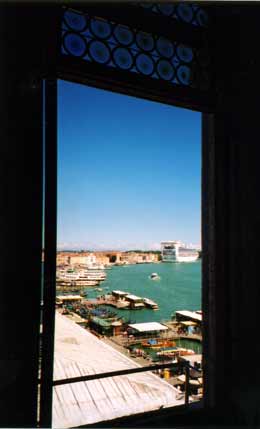 From a window in the Palazzo Ducale. That ship on the right
is not a gondola.
From a window in the Palazzo Ducale. That ship on the right
is not a gondola. |
I bought a book about the architecture, and we moved on
to the other obvious tourist site, the Palazzo Ducale, called the Doge's
Palace. Astonishingly, we found no line there, but wafted in. The separation
of the cities in Italy combined with the difficulties of transportation
over the centuries have led to root-level differences in their governments
and culture. This is especially true in Venice, where the unusual design
of the city afforded it isolation. Venice rather liked it that way, and
no where was this more apparent than at the Doge's Palace. A traditional
four-sided court design, the joint is very ornate, with statuary, armaments,
expansive oils and nearly ubiquitous gold leaf covering most available
surfaces. We saw a darling suit of armor, proportionally sized for a young
child (which would be a lot less cute if the little bugger was pinning
you down at swordpoint.) One of my favorite frescos, a typically flamboyant
ceiling, portrayed the spirit of Venice (a young woman, naturally) being
worshipped and glorified, and rejecting the poor Pope with a magnificent
Joan Crawford gesture. The Venetians did not care much for papal authority.
Jen and I crashed a passing tour, and learned that the Doge's authority
was physically reflected in the rooms to which Palace visitors were admitted.
Like many palaces (or, indeed, the Governor's Mansion in our own Williamsburg,
VA), the more important you were, the further in you got to get. The rooms
here got bigger as you moved deeper in, building up to a really immense
Senate chamber, with oils rivaling anything I've seen.
A sandwich in the courtyard seemed enough fuel to power
us along to wander the streets. This is the best plan of attack in Venice:
head "thataway." There is, in fact, something interesting just around
the next corner no matter which corner that happens to be. That afternoon,
most of these "something interestings" turned out to be shops. I'm not
sure whether it's the romance of saying "oh this old thing? I just picked
it up in Venice." or that the Old Things they sell are all indeed magnificent,
but we wandered shops until dusk. Linen, leather, Morano glass, cashmere
and silk pervade the city, and yeah I did buy a couple of ties. And a
carnival mask, thanks. Christmas shopping? Covered. Peckish? Una picccolo
gelatto chocolate, per favore. And I would have kept on, except that
Jen subtly hinted it was about time for dinner, so I clutched my bruised
forearm and we headed off on a quest for an interesting-looking restaurant
out of our copy of Fodor's. We wandered in a few wrong directions,
bumping once into our Texan dinner companions from the previous night,
who were about as lost as we. I caved in; we bought a street map.
You know, it really does help to read that fine print that says "reservations
strongly recommended." So we wandered off on, er, another quest!
to find an interesting-looking restaurant out of our copy of Fodor's.
This one paid off. Jen and I got a candlelight dinner by the Canal Grande:
risotto, cuttlefish and spranggio for dessert. Lots of the house white
wine and a champagne toast. We staggered back towards San Marco.
The piazza was transformed. This I had not seen twelve years' previously:
the nightlife of Venice is the ninth wonder of the world. The sidewalk
cafes are lined up next to each other, each sporting its own quintet
playing on a platform built in front, surrounded by tables . This night,
four such concerti al caffè battled it out for the tourists'
patronage, each orchestra with two violins, an accordion, a string bass
and a grand piano. They traded
|
